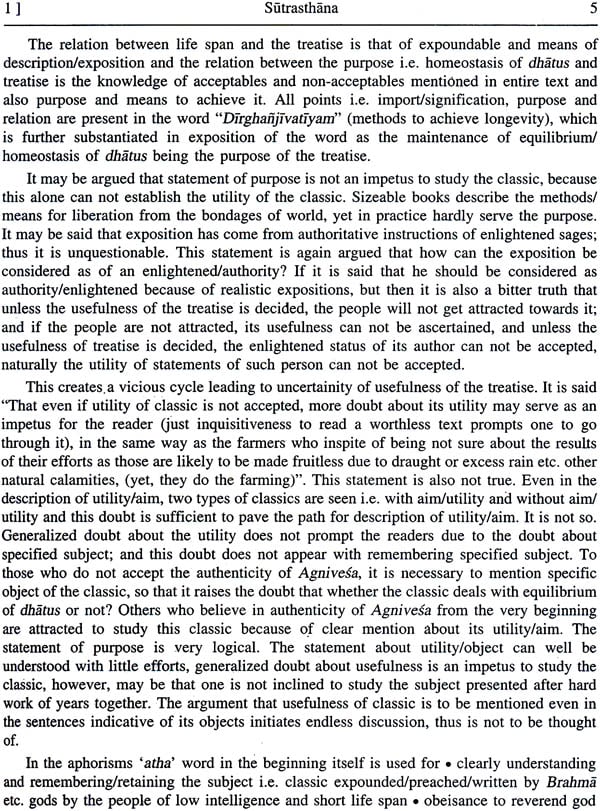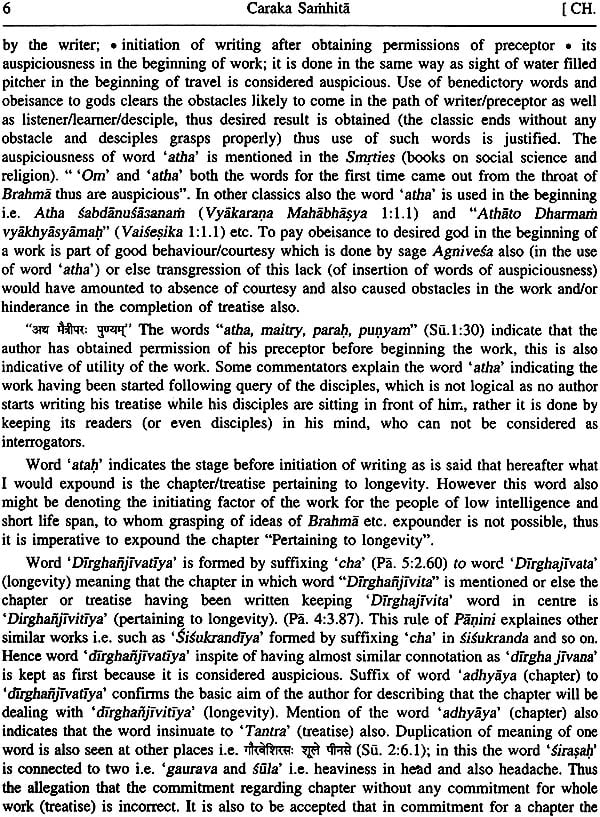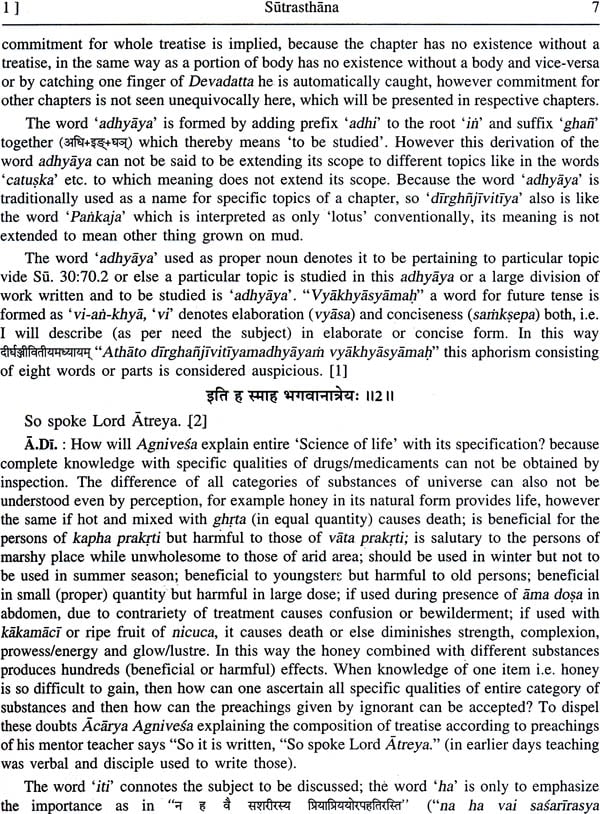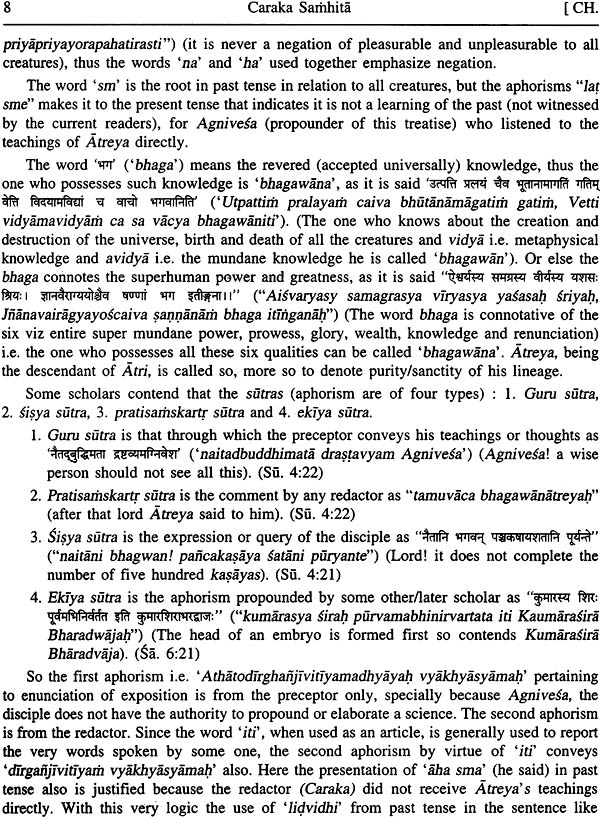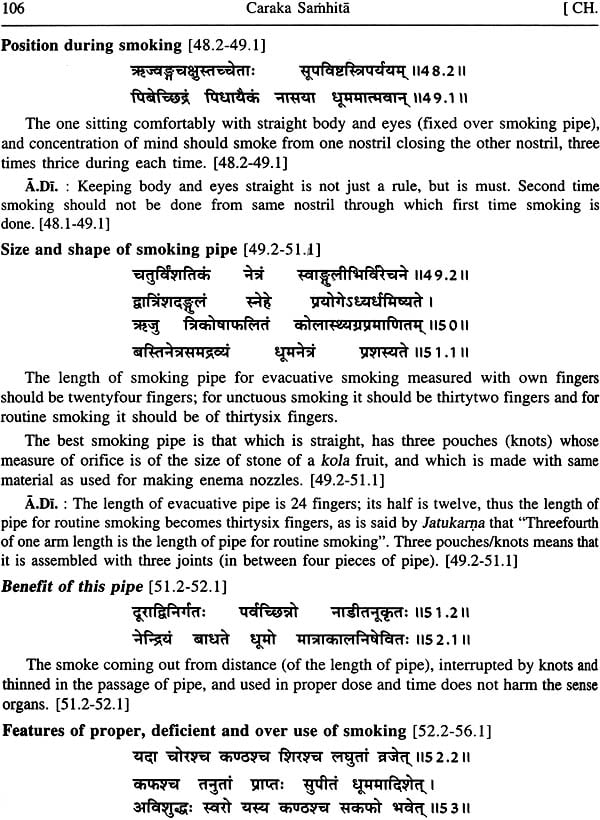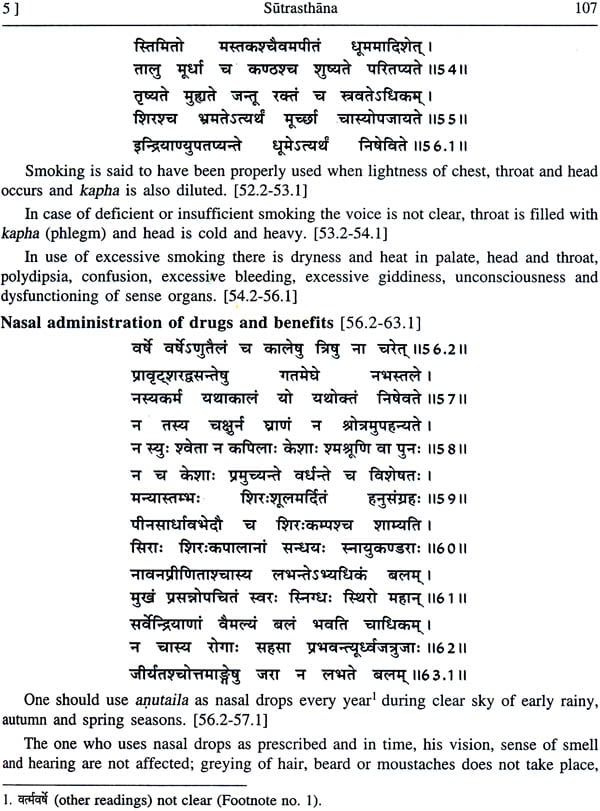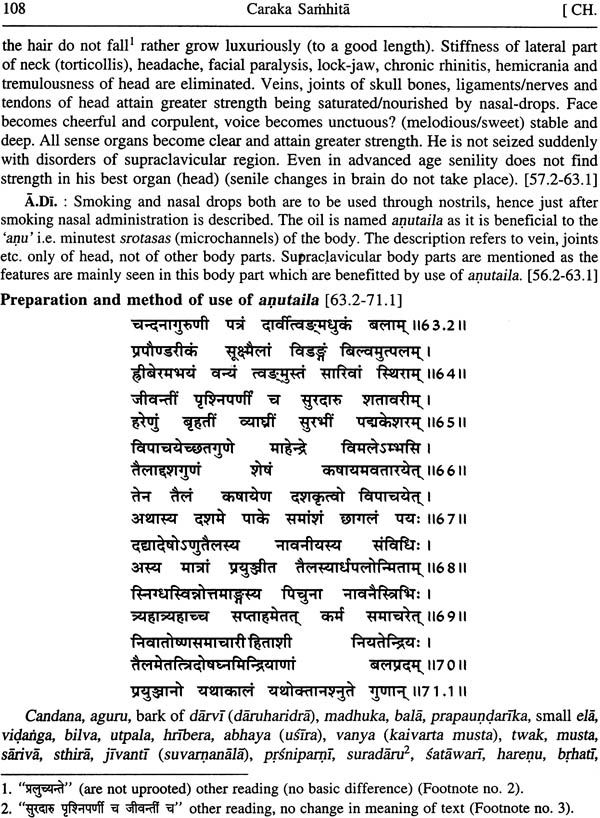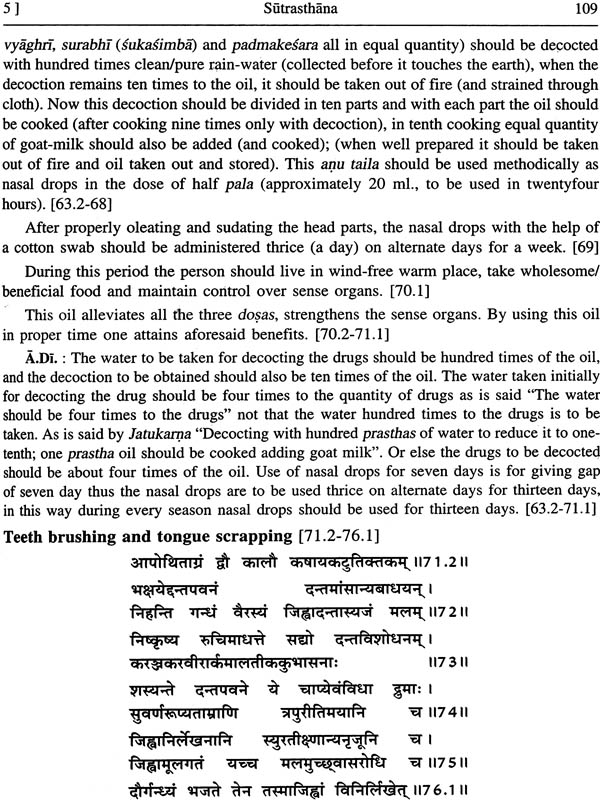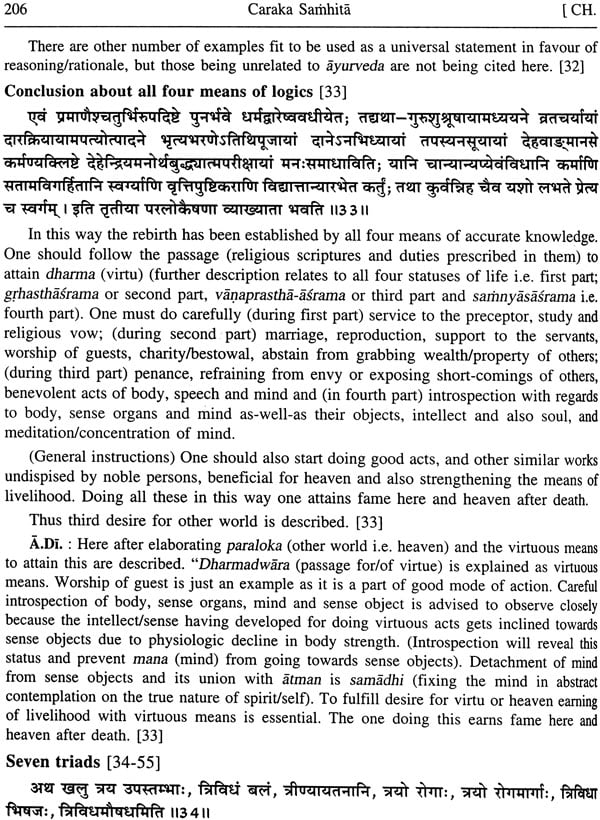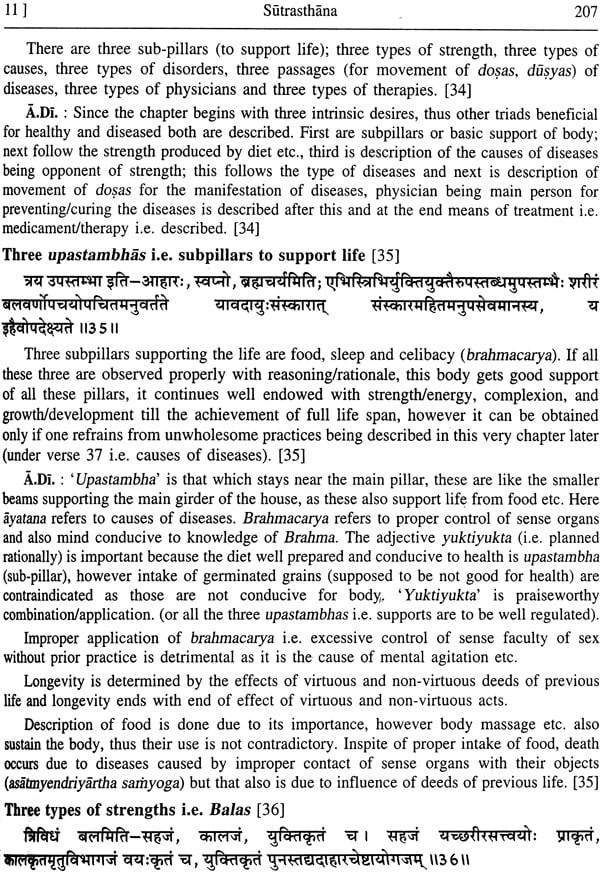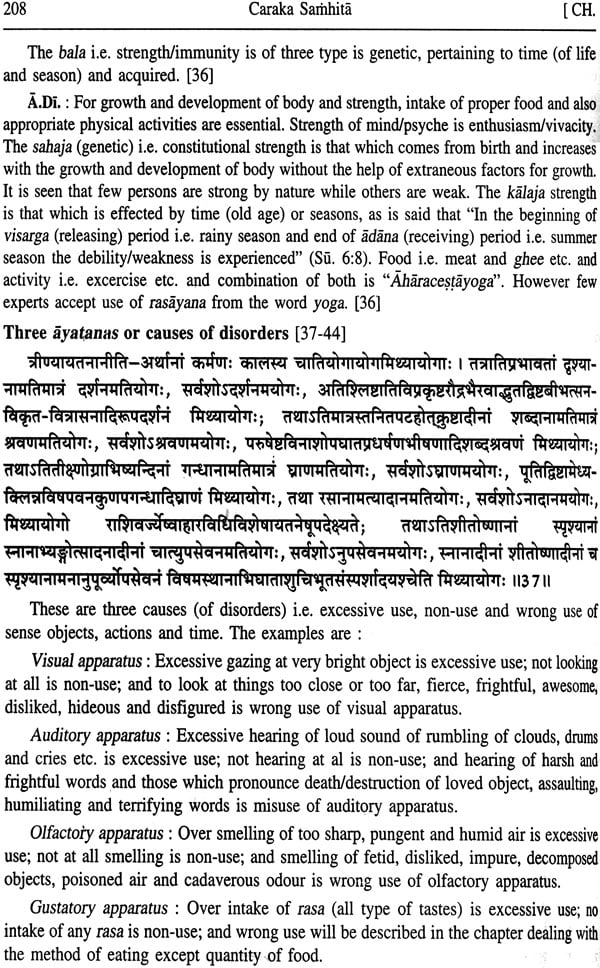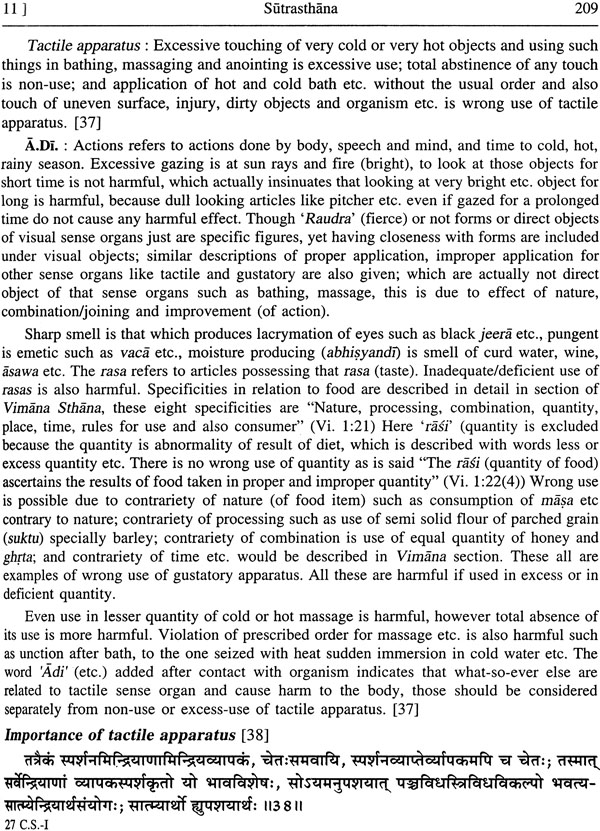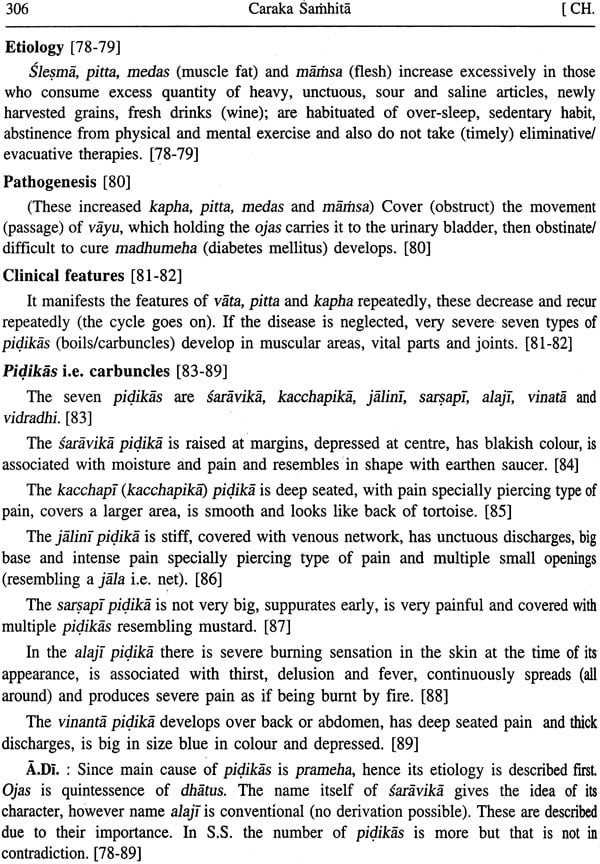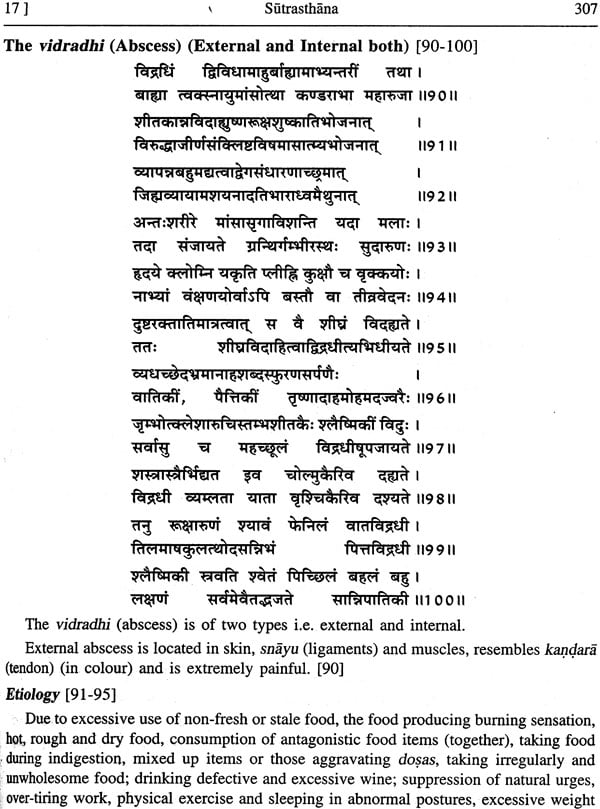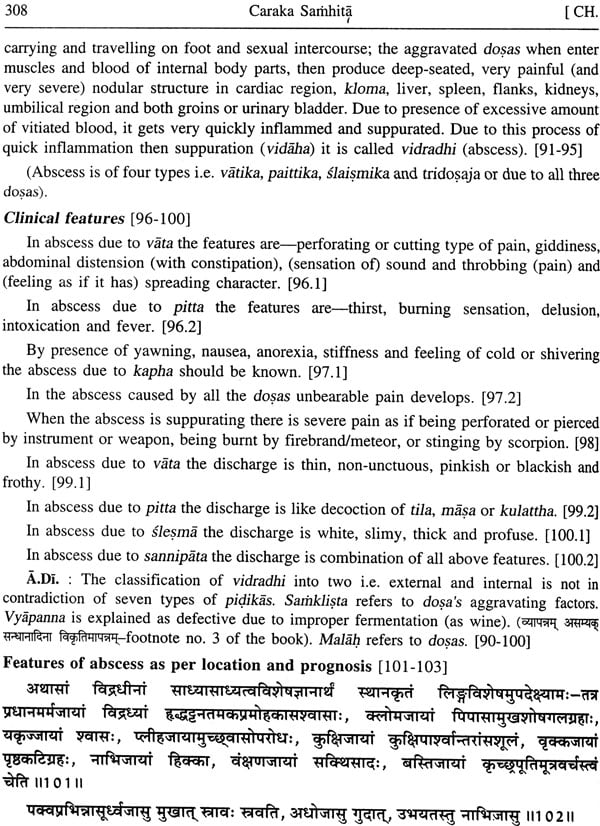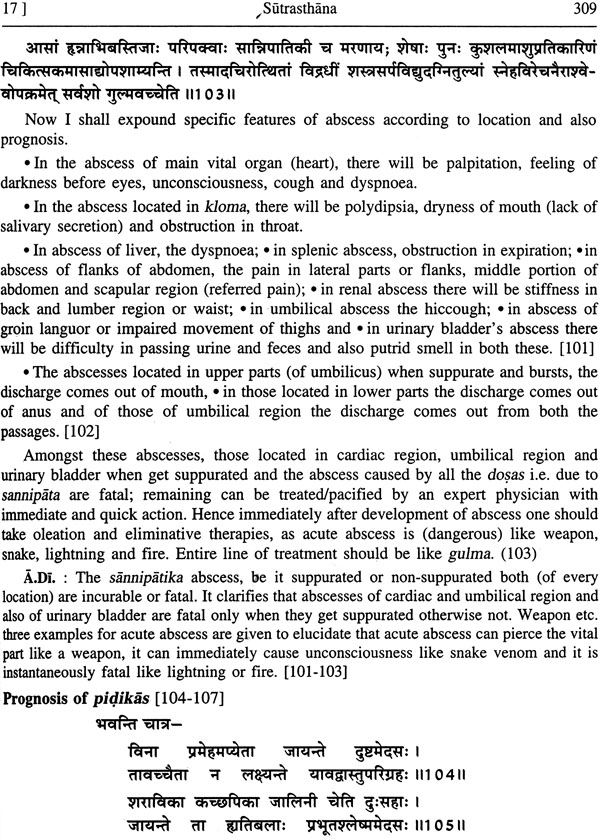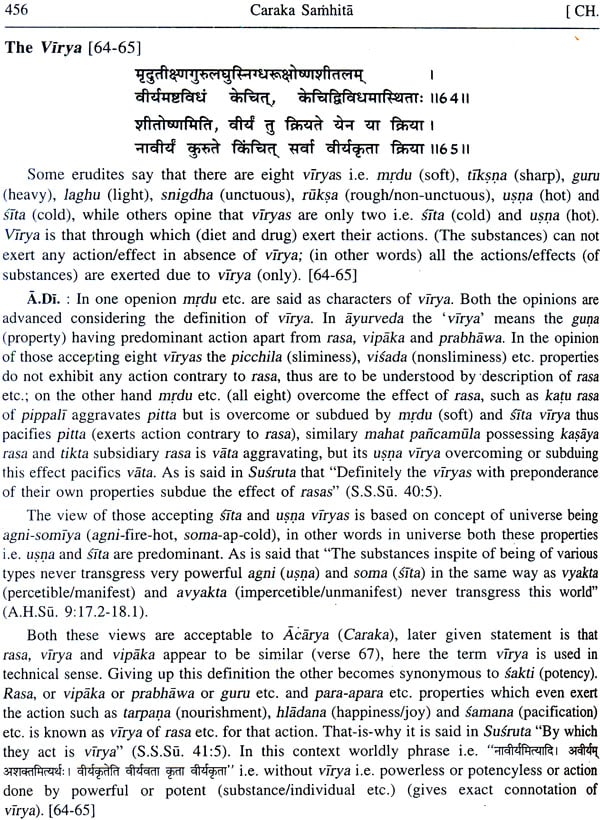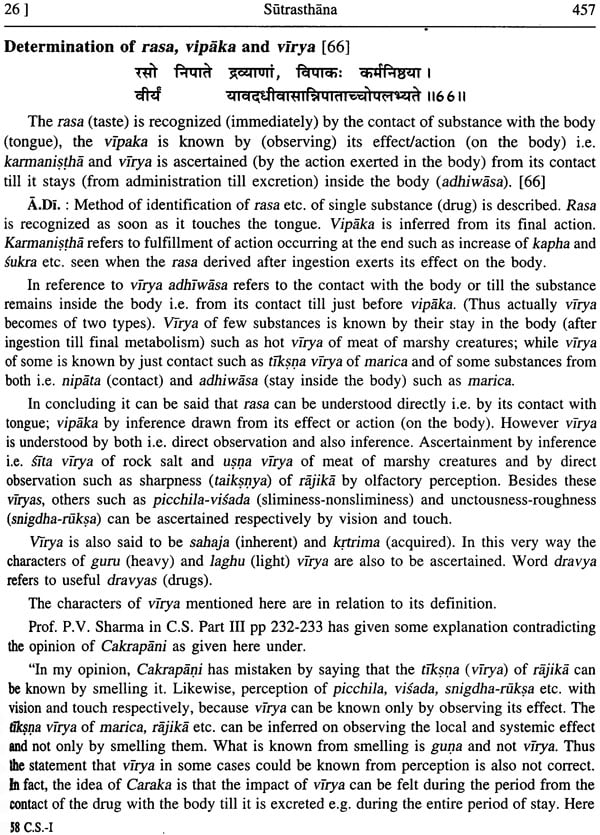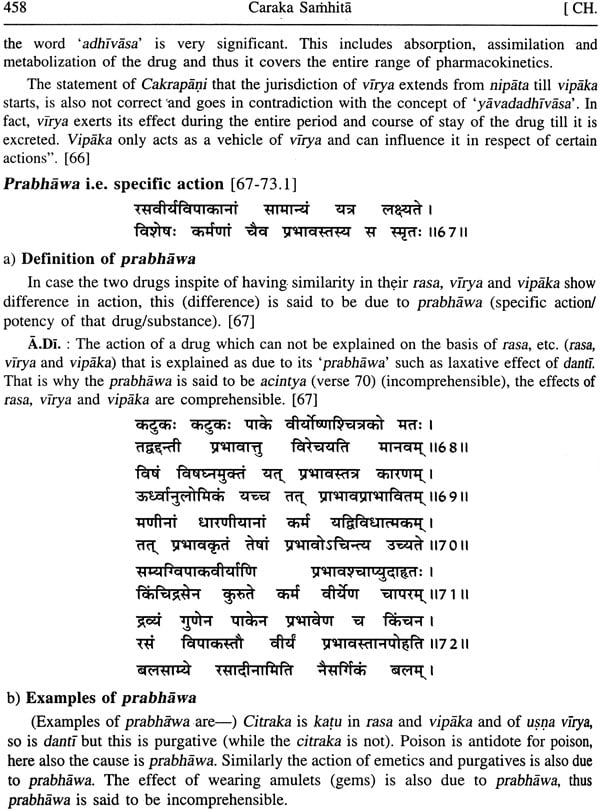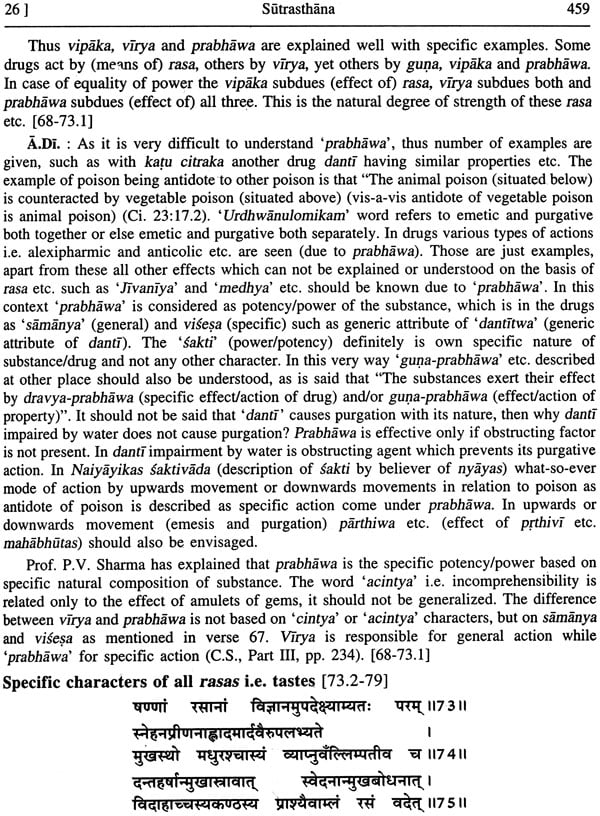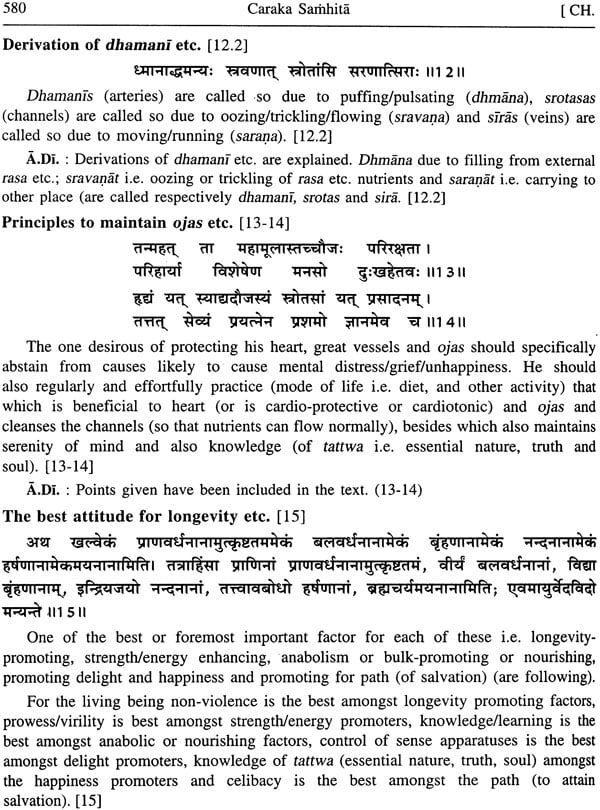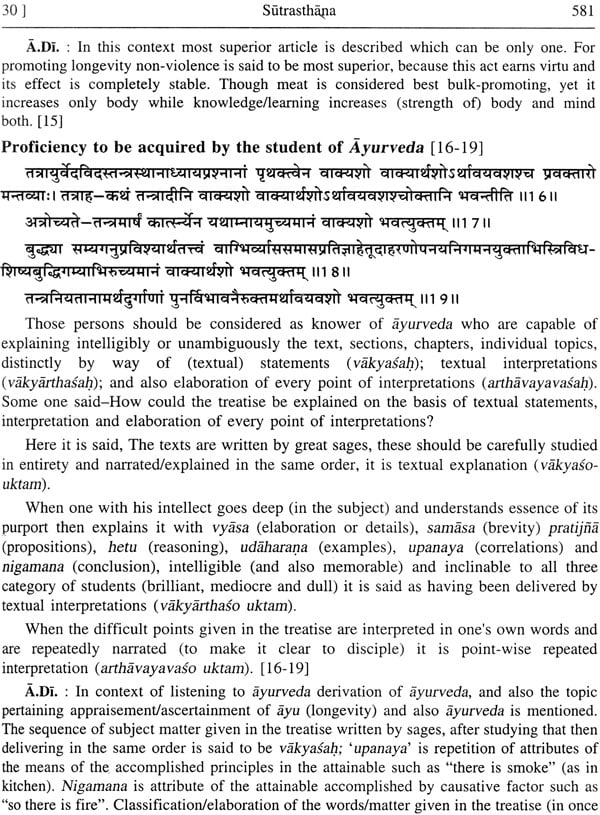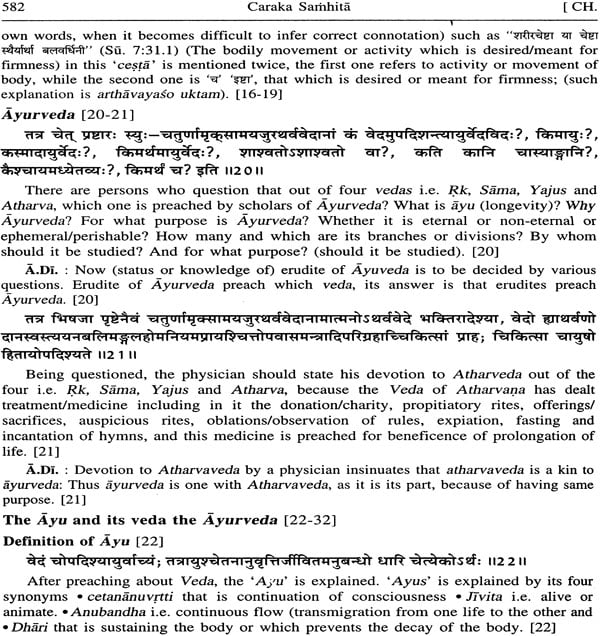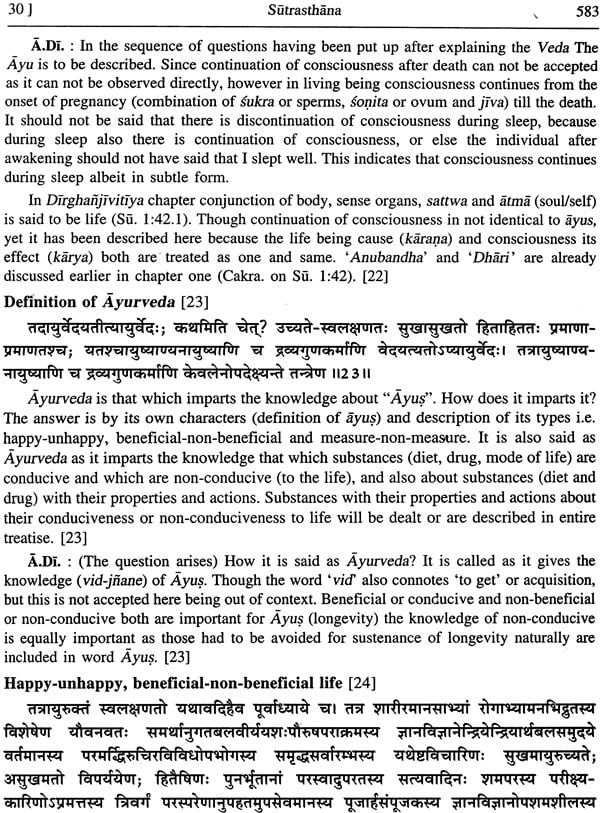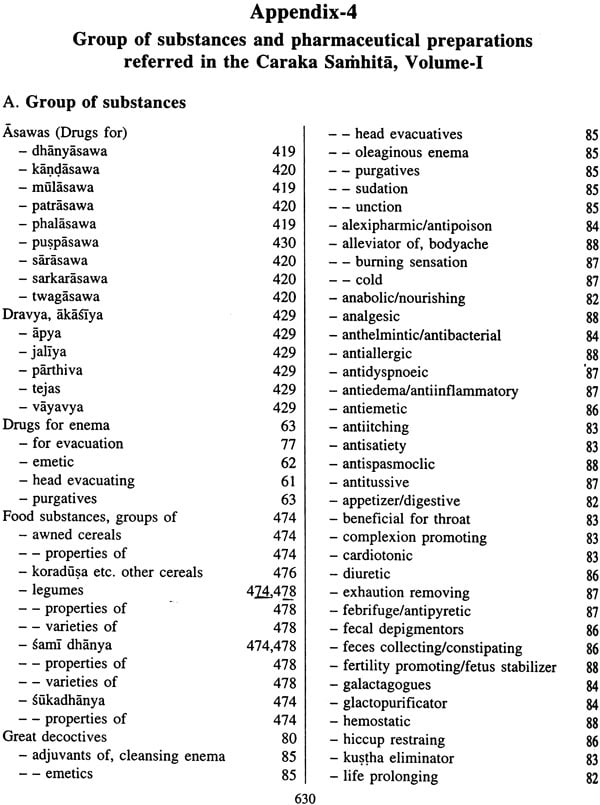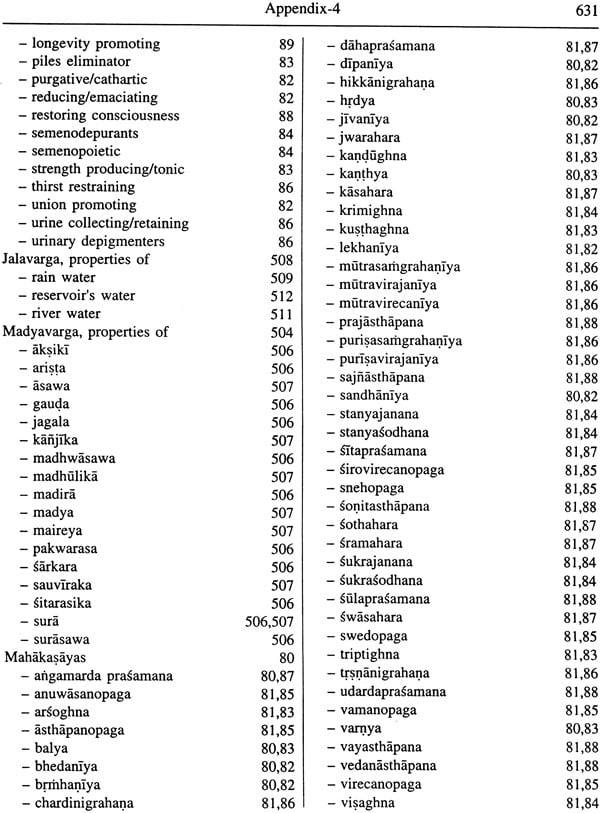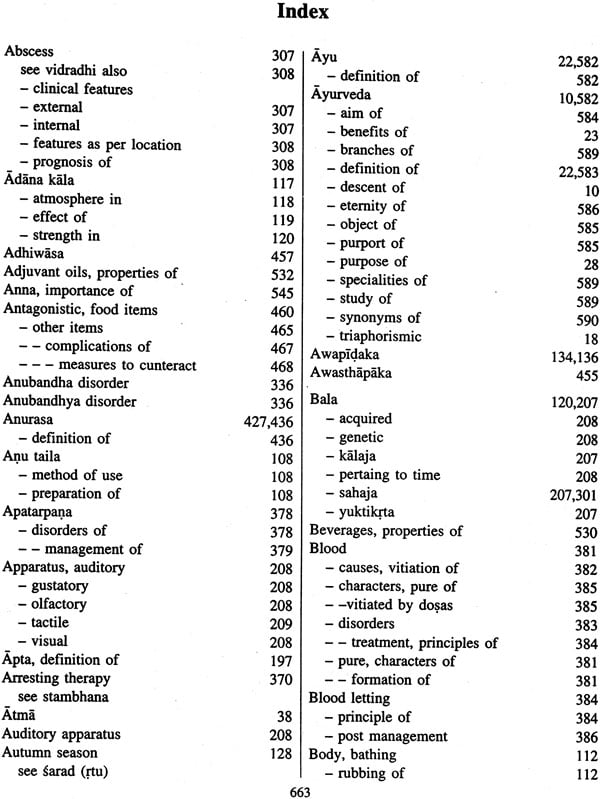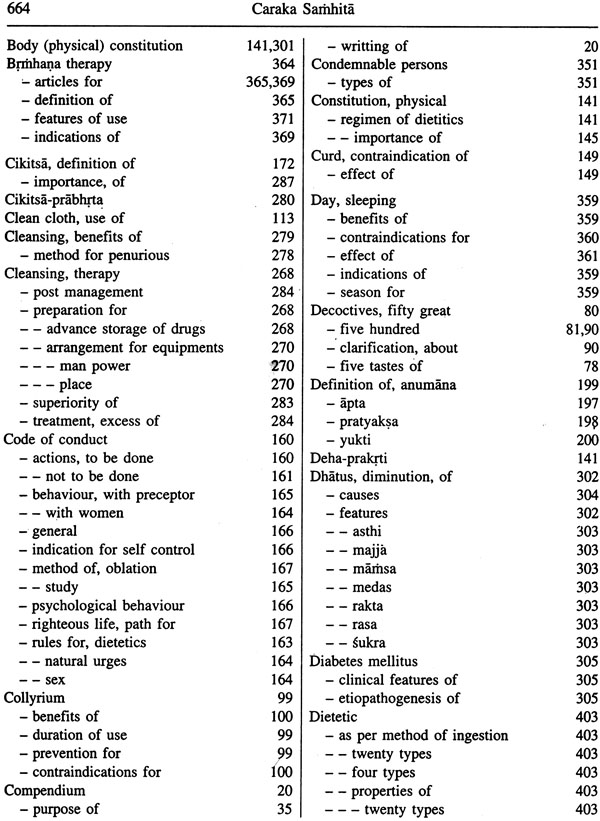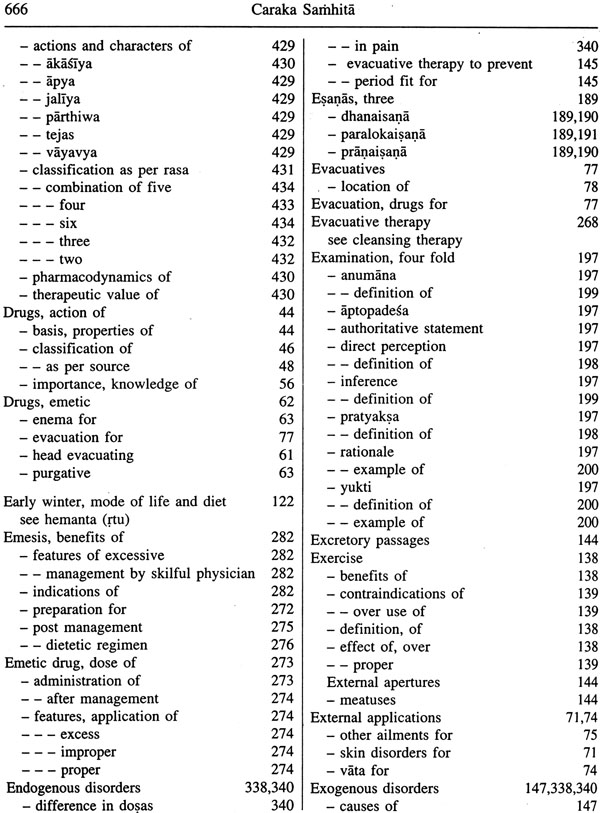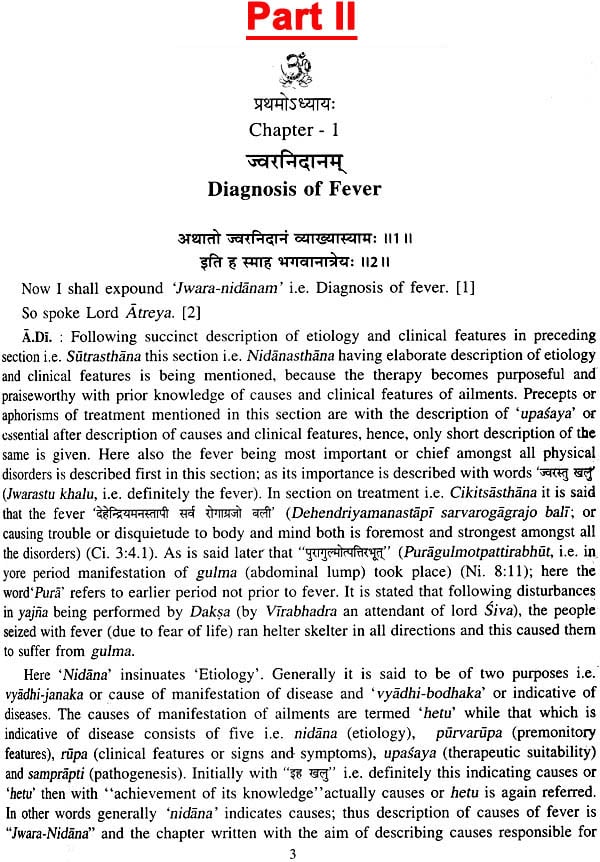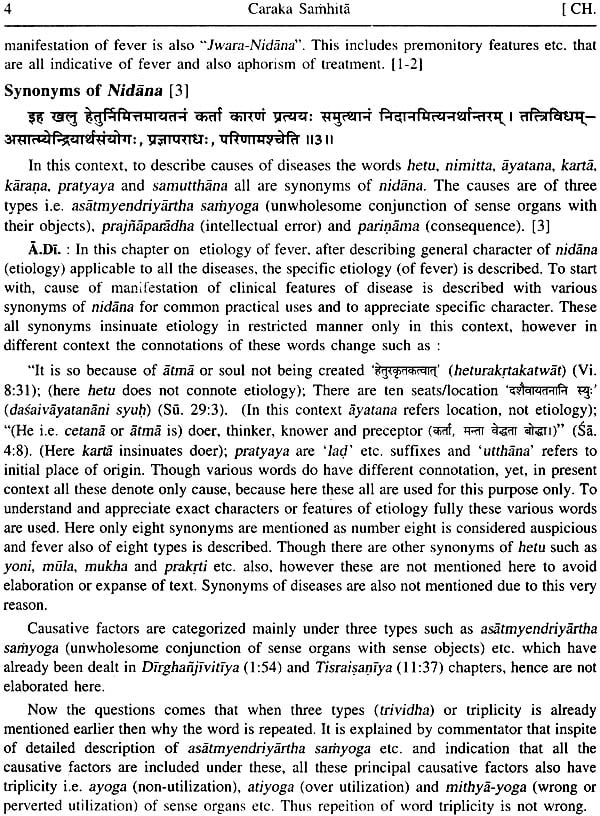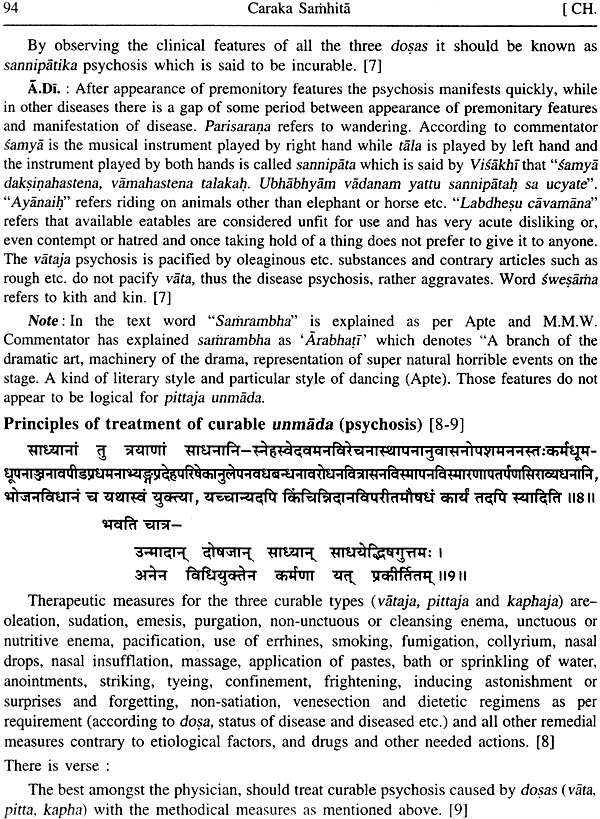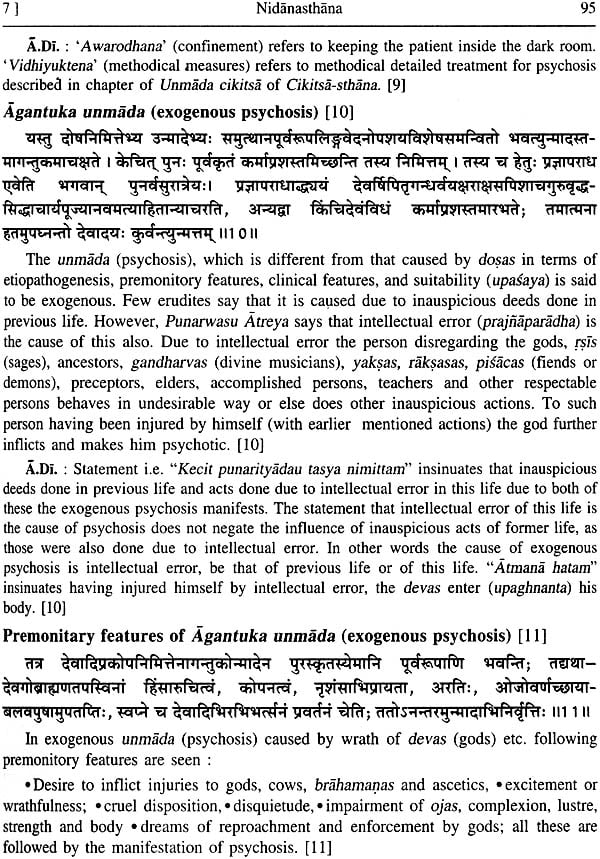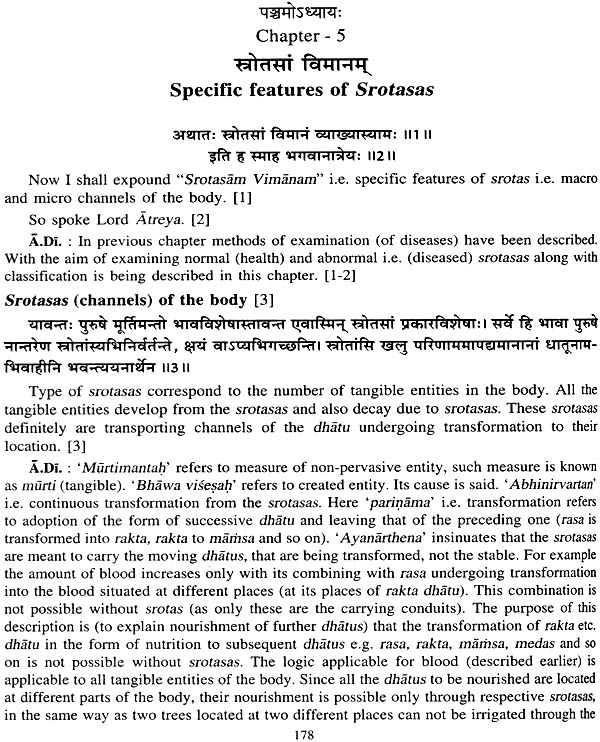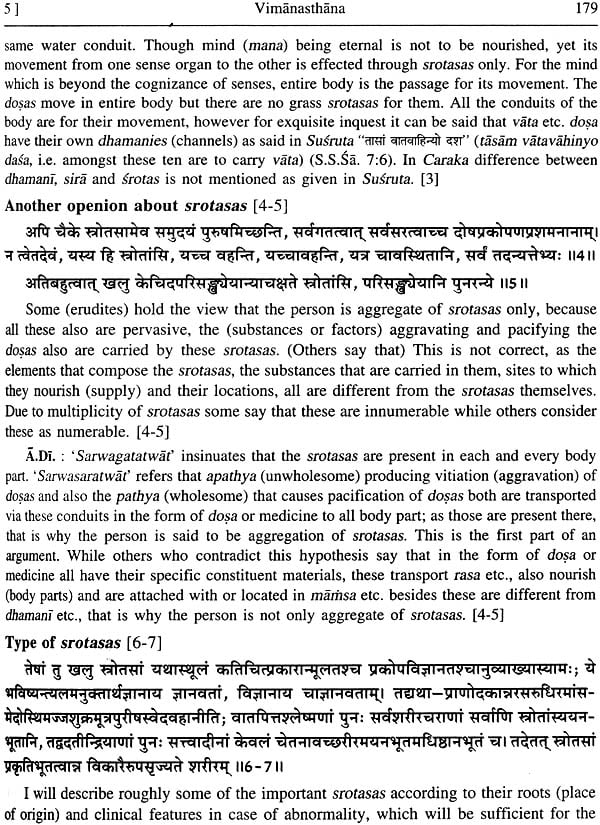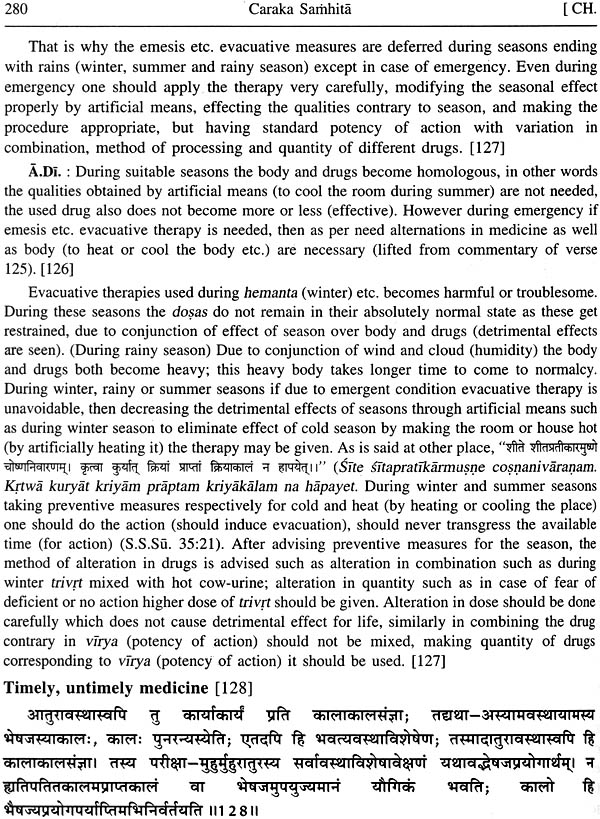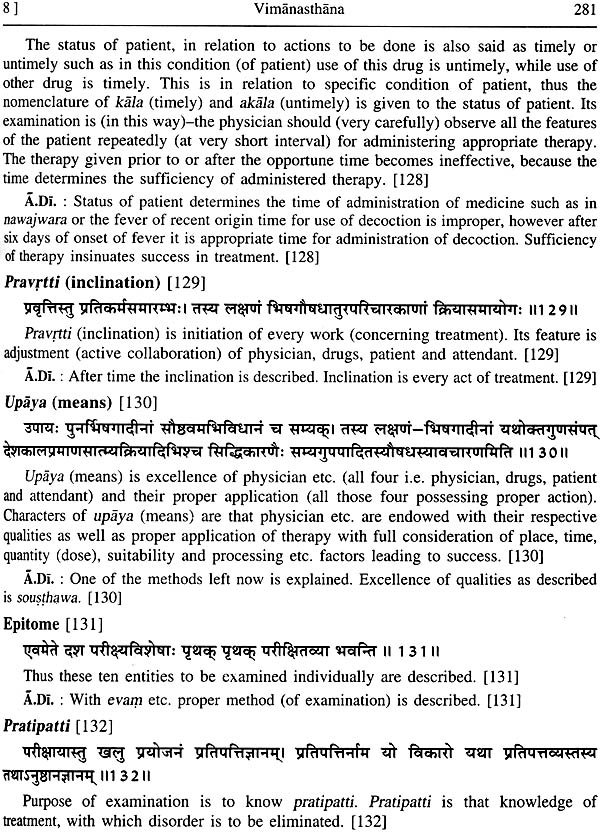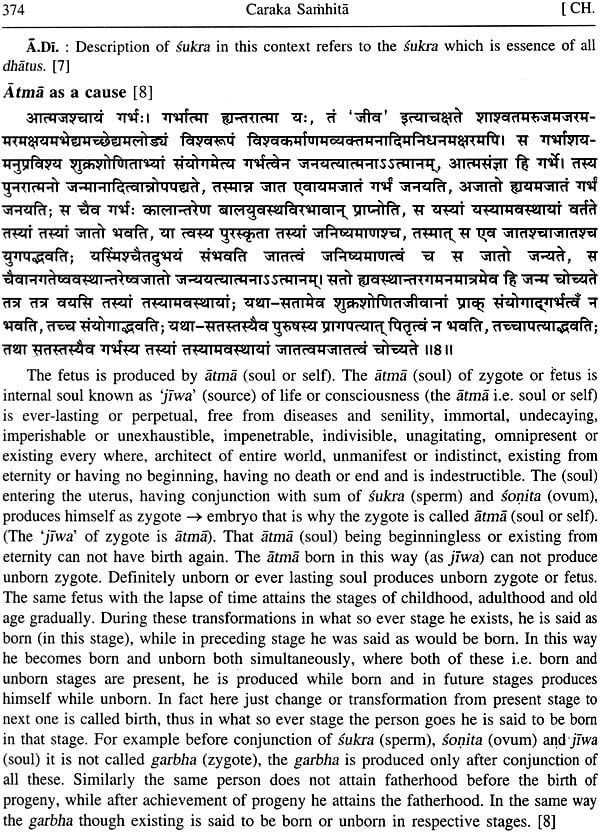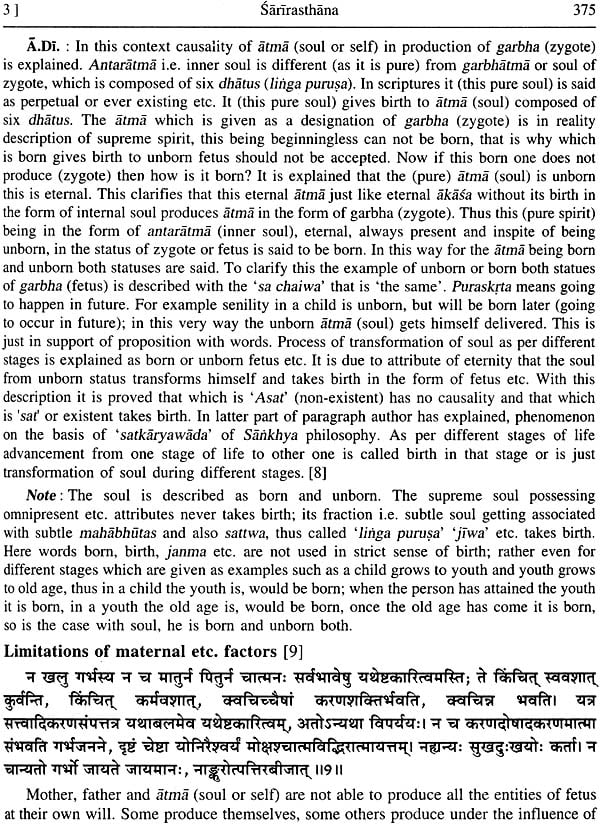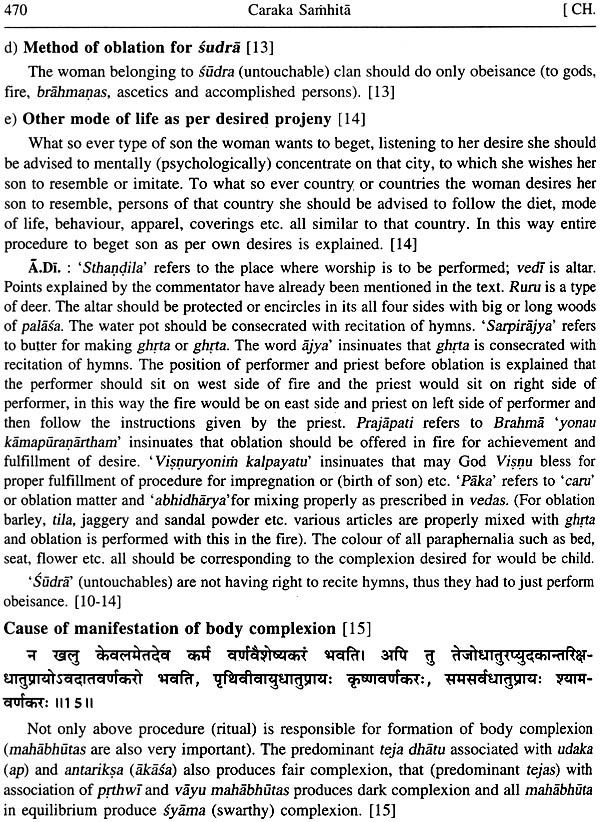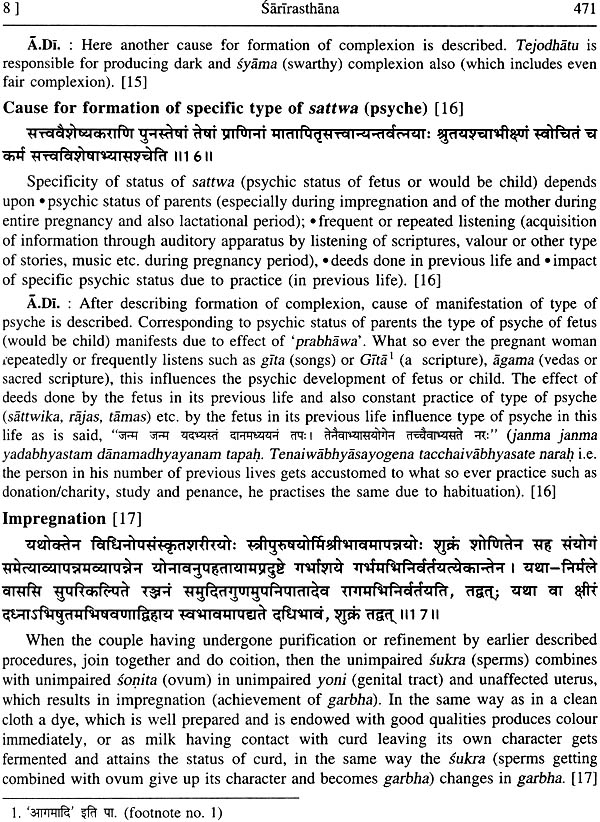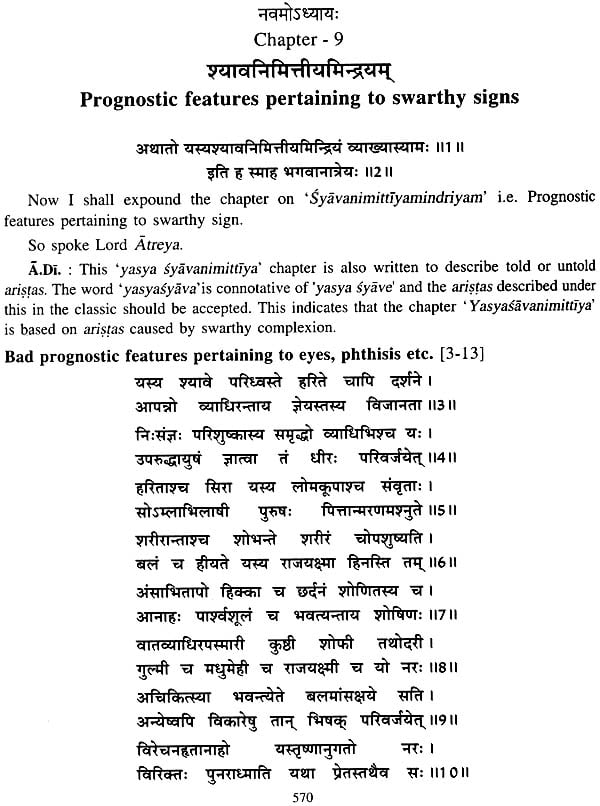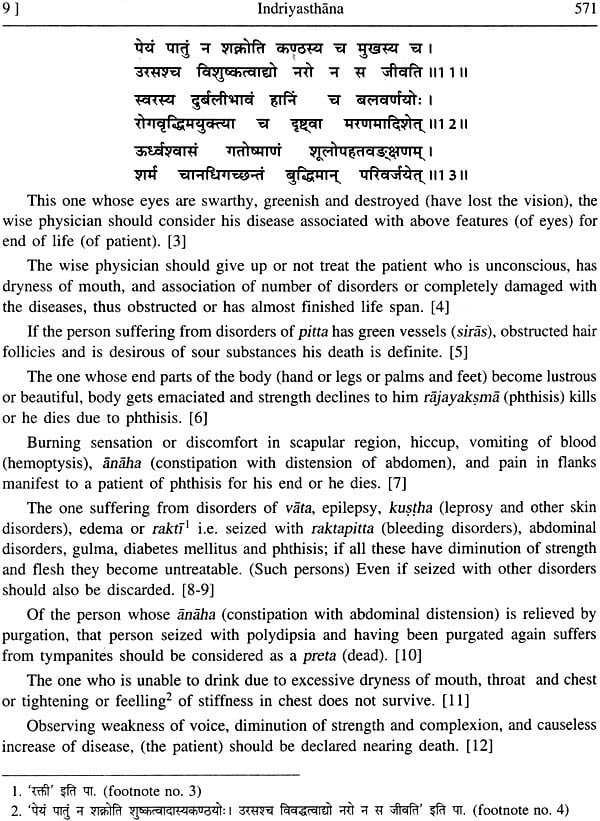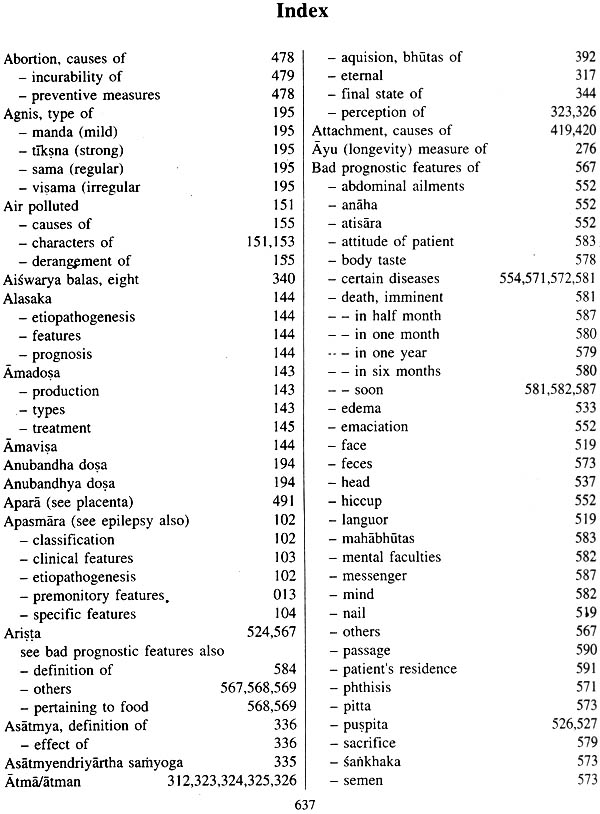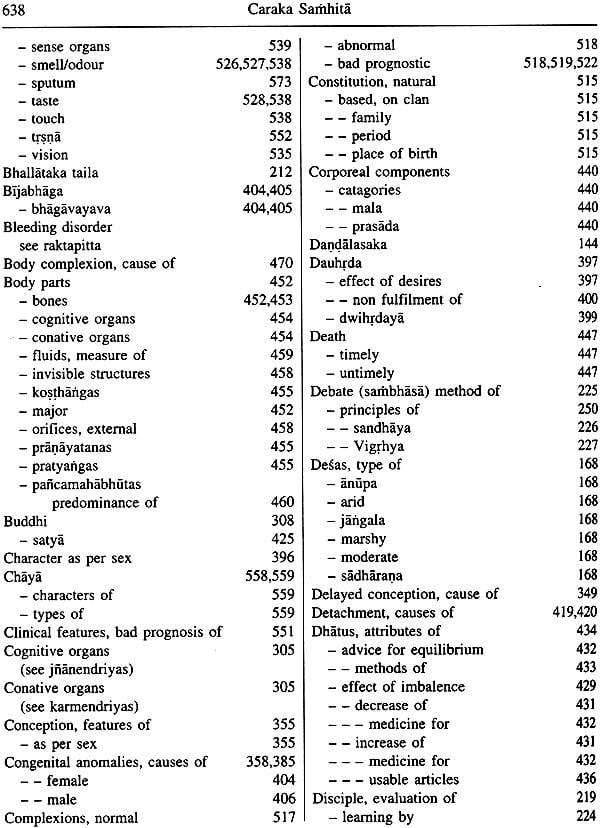
Caraka Samhita: Sutrasthana (The Only Edition with English Translation of Commentary Ayurveda Dipika by Cakrapani)
Book Specification
| Item Code: | NAL691 |
| Author: | Dr. P.V. Tewari |
| Publisher: | Chaukhambha Visvabharati , Varanasi |
| Language: | Sanskrit Text with English Translation |
| Edition: | 2017 |
| ISBN: | Vol. 1: 9789381301739 Vol. 2: 9789381301906 |
| Pages: | 1416 |
| Cover: | Hardcover |
| Other Details | 9.5 inch X 7.5 inch |
| Weight | 2.50 kg |
Book Description
Caraka Sarnhita (Volume I Sutra Sthana) English translation of text with Ayurveda Dipika commentary by Cakrapani Datta. Editor/ translator Prof. P.V.Tewari.
Caraka Samhita oldest treatise of Ayurveda describes not only Ayurveda, rather has dealt with all other aspects related to human psychosomatic health i.e. philosophy, sociology and religion including medical ethics etc. Luminaries of Ayurveda of this era have deliberated upon the treatise from different angles including English translation of text and also Ayurveda Dipika commentary. Every writer has own method of writing or explaining a subject which makes a difference in it's appreciation. In present book which is 1st volume of entire treatise, an attempt has been made to be nearer to actual connotations of subject as much as possible, with English translation of almost entire commentary barring repetition and also the points already incorporated in explaining the matter in the translation of the text.
To apprise a novice with the subject, in introduction of the book a bird's eye-view of the treatise, its originator Atreya the preceptor ? Agnivesa the essayist/compiler with status of first strata of C.S., ? Caraka the author of second strata with his period and ? Drdhabala the person who completed the book or writer of third strata along with his contribution is mentioned. This has followed a short introduction of commentator Cakrapani with his contributions.
For better appreciation and clear acceptability the topics have been given headings, which also helps in finding the concerned subject easily through contents as-well-as index.
After complete translation of this volume I (Sutra sthana) seven appendices are given which describe mainly modern or English equivalent of pathological entities, flora and fauna etc. This follows the index which makes it more accessible.
It is hoped that it will be useful for students', teacher and research workers a like.
About the Author
Dr. P.V. Tewari A.M.B.S., Ph.D., a well known academician, administrator and research workers was born on 5th August, 1937 to freedom fighters Shri Rama Shankar Tewari recipient of Tamrapatra awarded by Late Prime Minister Smt. Indira Gandhi and Mrs. Rama Devi Tewari having lost her life during 42 freedom movement. A throughout meritorious student has been serving Ayurveda for the last 57 years in different capacities at SAC Lucknow and B.H.U. and now is serving gratis Mata Anandamayee Hospital, Shivala, Varanasi, as Additional Medical Superintendent and senior Gynecologist. During her tenure of 36 years at B .H. U. served as Lecturer, Reader and Professor, Head Department of Prasuti Tantra, Dean, Faculty of Ayurveda twice, Director, WHO Research Centre and Coordinator, Faculty of Ayurveda and Ayurvedic Pharmaceuticals. She has also been associated with almost all important committees of universities and institutes of Ayurveda and also Ministry of Health, Govt. of India.
As a dedicated research worker has guided 53 D.Ay. M./MD. Ay. scholars and 21 Ph.Ds.; has published 258 scientific papers in National and International Journals and attended sizeable National and International conferences. She has received seventeen awards, citations and honours.
A prolific writer has written preface/forewords of sixteen books related to Prasuti- Striroga and Kaumarabhrtya; published 18 books, contributed 7 chapters and edited three Journals and is continuing to serve goddess Saraswati.
It gives me great pleasure to write a few words about the English translation done by Prof. (Dr.) P.V. Tewari, Ex. Head Department of Prasuti Tantra, I.M.S., B.H.U., Varanasi, India of Acharya Chakrapani on Charaka Samhita, the most effective treatise on medical treatment. The translation done by Prof. Tewari is no doubt, simple and easy for understanding. The sanskrit commentary is difficult to understand particularly the philosophical aspect.
Sri Chakrapani is from Bengal and belongs to 11th centuary A.D. As regards drugs he has a special tradition of giving equivalents in local language with some details about its identity.
I bless Prof. Tewari to write such books on Ayurveda in future also for the benefit of Ayurveda Scholars.
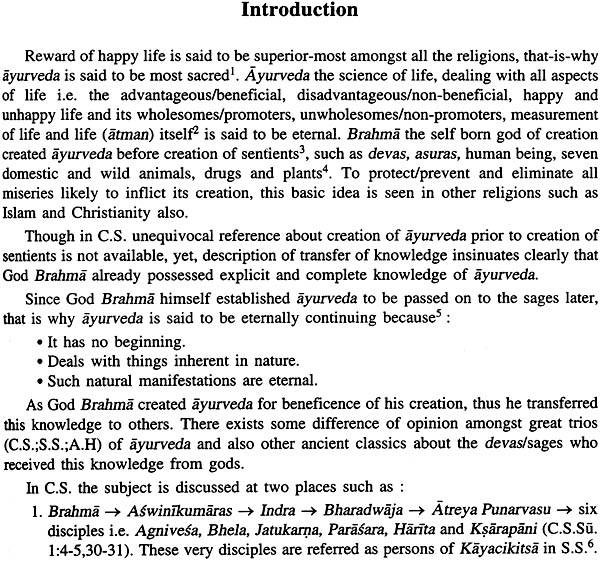
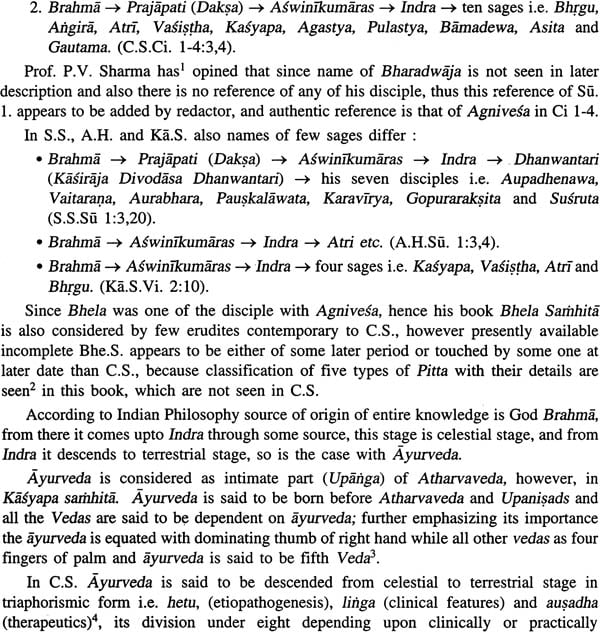
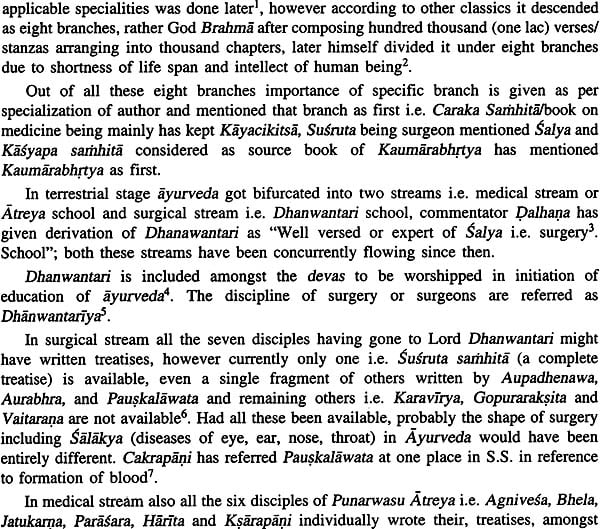
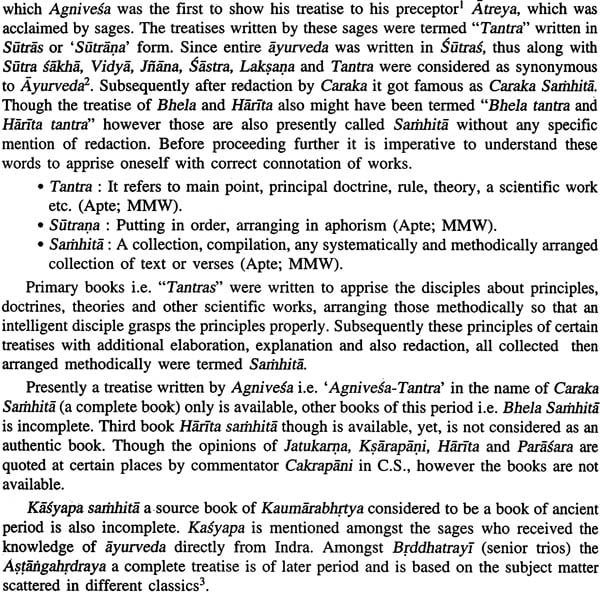
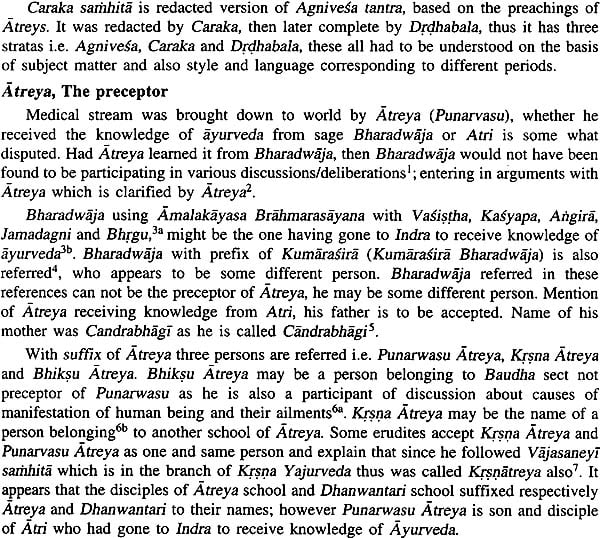
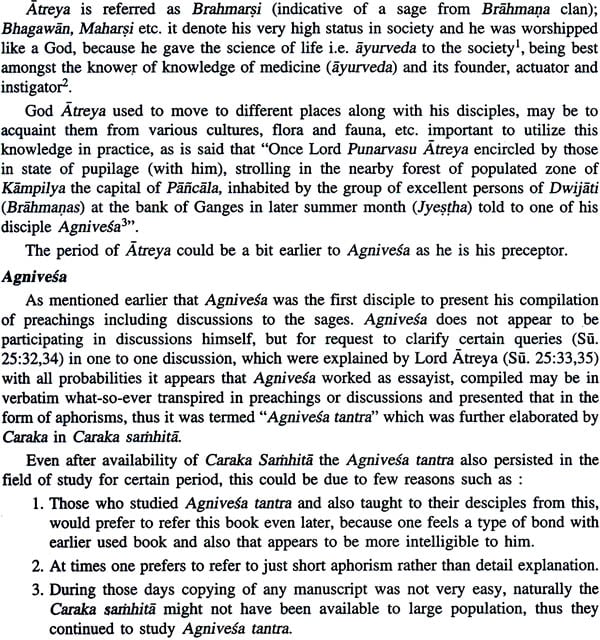
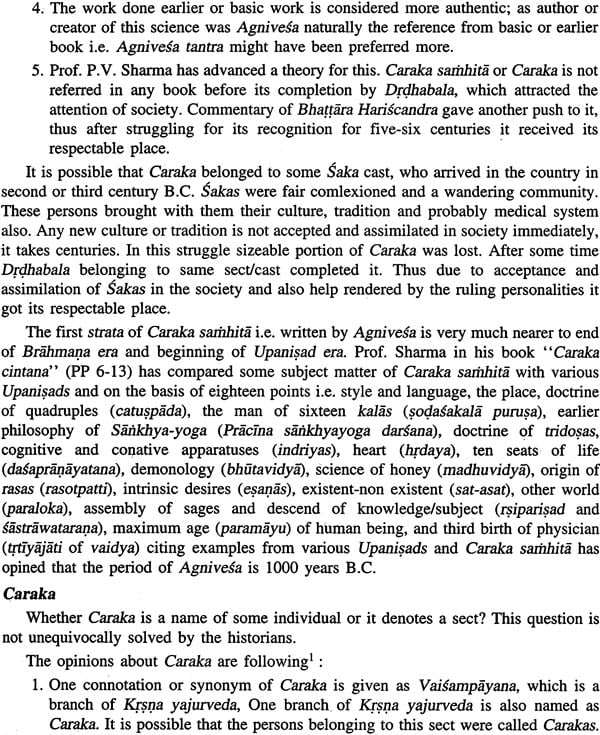
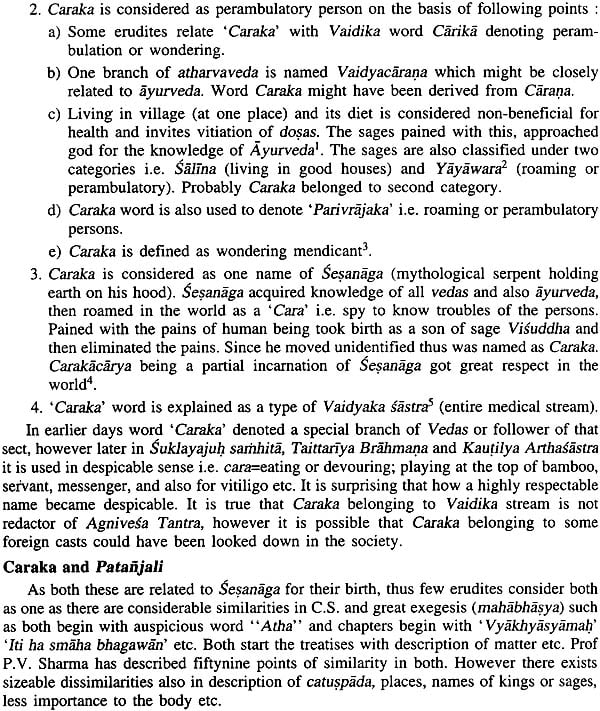
| Foreword | xvii |
| Introduction | xix |
| Abbreviations of Books and Sections | lix |
| Key to Transliteration | lx |
| Chapter-1 | |
| The chapter pertaining to 'Longevity' | 3-60 |
| Chapter-2 | |
| The chapter pertaining to 'Dehusked seeds of Apamarga' | 61-70 |
| Chapter-3 | |
| The chapter pertaining to 'Aragvadha' | 71-76 |
| Chapter-4 | |
| The chapter pertaining to 'Six hundred Evacuatives' | 77-92 |
| Chapter-5 | |
| The chapter pertaining to 'Quantitative dietetics' | 93-116 |
| Chapter-6 | |
| The chapter pertaining to 'One's diet' | 117-131 |
| Chapter-7 | |
| The chapter pertaining to 'Non-suppression of natural urges' | 132-151 |
| Chapter-8 | |
| The chapter pertaining to 'Description of sense organs' | 152-169 |
| Chapter-9 | |
| The chapter pertaining to 'Short quadruple of therapeutics' | 170-178 |
| Chapter-10 | |
| The chapter pertaining to 'Great quadruple of therapeutics' | 179-188 |
| Chapter-11 | |
| The chapter pertaining to 'Three basic desires' | 189-219 |
| Chapter-12 | |
| The chapter pertaining to 'Merits and demerits of vata' | 220-228 |
| Chapter-13 | |
| The chapter pertaining to 'Oleation/unction' | 229-250 |
| Chapter-14 | |
| The chapter pertaining to 'Sudation' | 251-267 |
| Chapter-15 | |
| The chapter pertaining to 'Preparation of cleansing therapy' | 268-279 |
| Chapter-16 | |
| The chapter pertaining to 'Skilful Physician' | 280-288 |
| Chapter-17 | |
| The chapter pertaining to 'Number of Head-disorders' | 289-313 |
| Chapter-18 | |
| The chapter pertaining to 'Three swellings Inflammations/edemas' | 314-327 |
| Chapter-19 | |
| The chapter pertaining to 'Eight Abdominal disorders' | 328-337 |
| Chapter-20 | |
| The chapter pertaining to 'Major disorders' | 338-350 |
| Chapter-21 | |
| The chapter pertaining to 'Eight condemnable persons' | 351-363 |
| Chapter-22 | |
| The chapter pertaining to 'Reducing and nourishing/promoting measures' | 364-373 |
| Chapter-23 | |
| The chapter pertaining to 'Satiating/saturating procedure' | 374-380 |
| Chapter-24 | |
| The chapter pertaining to 'Precepts of blood' | 381-392 |
| Chapter-25 | |
| The chapter pertaining to 'The origin of person' | 393-421 |
| Chapter-26 | |
| The chapter pertaining to 'Discussion between Atreya and Bhadrakapya' | 422-470 |
| Chapter-27 | |
| The chapter pertaining to 'Precepts of Food and Drink' | 471-546 |
| Chapter-28 | |
| The chapter pertaining to 'Various types of Foods and Drinks' | 547-567 |
| Chapter-29 | |
| The chapter pertaining to 'Ten seats of life' | 568-574 |
| Chapter-30 | |
| The chapter pertaining to 'Ten great vessels with roots in heart' | 575-602 |
| Bibliography | 603-604 |
| Appendices | 605-662 |
| Index | 663-676 |
Volume II
About the Book
This book is English translation of Caraka Samhita including Ayurveda Dipika commentary of Cakradatta Vol. II consisting of four sections namely Nidana Sthana, Vimana Sthana, Sarira Sthana and Indriya Sthana, which is written in the pattern of volume I.
In first volume of the book based on Sutrasthana mainly philosophical aspects pertaining not only to ayurveda, rather entire life of individual i.e. socio cultural, religious and ethical aspects and also basic concepts of ayurveda are discussed. This second volume is devoted to the subject, which enables a learner to become perfect vaidya capable of independently treating a patient.
It starts with emphasis on importance and also methods to assess etiopathogenesis, premonitory features, clinical features as well as therapeutic tests to diagnose a disease. It goes further describing various aspects important for treating the patient such as relation between rasas (taste the pacifying agents) and dosas, the causative factors of diseases; method of education, relation between teacher and taught, methods of thorough examination of patient to assess his physical and psychological normalcy as well as morbidity; special dietetic preparation for the patient, preventive measures of epidemics etc.
Detailed description of measures to obtain healthy progeny, growth and development, major and minor structures and also detailed physiology of body the substratum of treatment; prognostic features of various disorders with advice to avoid treating moribund patient lest one gets defamation and disrespect in the society are described.
In this volume also for better appreciation and clear acceptability the topics have been given headings, which also helps in finding the concerned subject easily through contents as-well-as index.
After complete translation of this volume II (Nidanasthana, Vimanasthana Sarirasthana & Indriyasthana) appendices are given which describe mainly modern or English equivalent of pathological entities, flora and fauna etc. This follows the index which makes it more accessible. It is hoped that it will be useful for students', teacher and research workers alike.
Few Words
Second volume of English translation of Caraka Samhita with Ayurvedadipika commentary of Cakrapanidatta consisting of four sections i.e. Nidana, Vimana, Sarira and Indriya sthana is presented to ayurvedic world. In first volume introduction of the book along with the method of presentation, acknowledgment etc. all has already been given. To substantiate one statement i.e. “Probably Cakrapani had used some other mss. Of C.S., S.S., A.H.” the difference of words in given quotations and matter available in presently available text is presented in appendix one. Since this appendix neither gives any new idea nor helps in advancing the knowledge of ayurveda, thus is not being given in this volume. Similarly metals and minerals and also weights and measures referred are very few, and already translated, thus these appendices are also not given.
I have no words to express my gratitude to young exponent ayurveda professor Dr. Sandhya Patel, Kaumarbhritya Department, J.S. Ayurveda College, Nadiad, Gujarat for her Naisthiki help given in this volume. Inspite of her over busy schedule she has gone through entire manuscript and suggested some modification in language to make it make it more intelligible, besides certain syntactical, grammatical and also spelling corrections. She has also assured to continue this help in subsequent volumes also. I can only prey god to shower upon her energy, wisdom, good health and longevity to serve ayurveda and goddess Saraswati with dedication, devotion, determination and timely correct decision.
I hope that erudite would pardon me for any shortcomings of this volume.
CONTENTS
| Few Words | vii | |
| Abbreviations of Book and Sections | viii | |
| Key to Transliteration | ix | |
| Nidanasthana (Section on Diagnosis) | ||
| Chaptet 1 | Diagnosis of Fever | 3-34 |
| Chaptet 2 | Diagnosis of Raktapitta i.e. Bleeding Disorders | 35-44 |
| Chaptet 3 | Diagnosis of Gulma – Abdominal Lump | 45-54 |
| Chaptet 4 | Diagnosis of Prameha | 55-68 |
| Chaptet 5 | Diagnosis of Kustha | 69-78 |
| Chaptet 6 | Diagnosis of Sosa or Phthisis | 79-89 |
| Chaptet 7 | Diagnosis of Unmada or Psychosis | 90-101 |
| Chaptet 8 | Diagnosis of Apasmara i.e. Epilepsy | 102-116 |
| Vimanasthana (Section on Specific Characters) | ||
| Chapter 1 | Specific characters of Rasa | 119-139 |
| Chapter 2 | Specific characters of three types of kuksi i.e. Stomach | 140-148 |
| Chapter 3 | Specific characters of Epidemics | 149-169 |
| Chapter 4 | Three methods of diagnosis specific diseases | 17-177 |
| Chapter 5 | Specific features of Srotasas | 178-188 |
| Chapter 6 | Specific features of diseases | 189-201 |
| Chapter 7 | Specific features of Patients | 202-215 |
| Chapter 8 | Specific therapeutics of Diseases | 216-295 |
| Sarirasthana (Section on Study of Human Body) | ||
| Chapter 1 | Various states of Purusa – Atman | 299-345 |
| Chapter 2 | Atulya Gotriyam – Non-consanguinity | 346-366 |
| Chapter 3 | Minor chapter of Descend of – Jiwa with Sattwa in Garbha | 367-389 |
| Chapter 4 | Major chapter on Descend of – Jiwa with Sattwa in Garbha | 390-414 |
| Chapter 5 | Enumeration of Entities of Human-being | 415-428 |
| Chapter 6 | Enumeration of Entities of Body | 429-450 |
| Chapter 7 | Enumeration of Body-Parts | 451-463 |
| Chapter 8 | Measures of procreation | 464-507 |
| Indriyasthana (Section on Prognostic features) | ||
| Chapter 1 | Prognostic features pertaining to Complexion and Voice | 511-523 |
| Chapter 2 | Prognostic features pertaining to Body odour simulating flowers | 524-529 |
| Chapter 3 | Prognostic features pertaining to touch or palpation | 530-533 |
| Chapter 4 | Prognostic features pertaining to sense organs | 534-540 |
| Chapter 5 | Prognostic features pertaining to premonitory features | 541-550 |
| Chapter 6 | Prognostic features pertaining to corporeal status | 551-556 |
| Chapter 7 | Prognostic features pertaining to disfigured shadow or reflected images | 557-564 |
| Chapter 8 | Prognostic features pertaining to inverted image of head | 565-569 |
| Chapter 9 | Prognostic features pertaining to swarthy signs | 570-574 |
| Chapter 10 | Prognostic features pertaining to sudden death | 575-578 |
| Chapter 11 | Prognostic features pertaining to diminished body-fire | 579-585 |
| Chapter 12 | Prognostic features pertaining to cow dung-like powder | 586-601 |
| Appendices: | 603-636 | |
| Index | 637-648 |
Volume I
